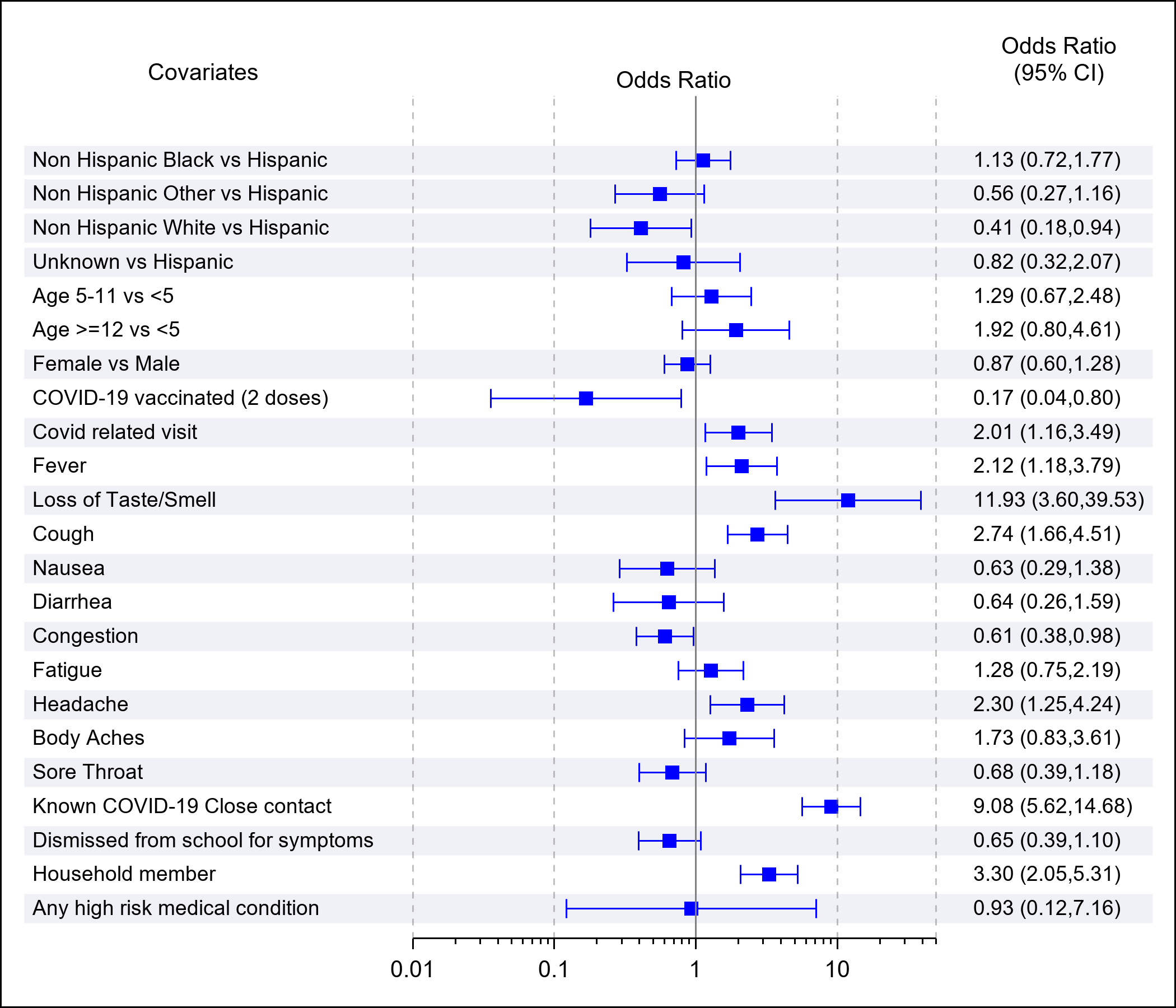Infectious Diseases
Category: Abstract Submission
Infectious Diseases: COVID-19
301 - Risk Factors for SARS-CoV-2 Infection in an Ambulatory Setting
Saturday, April 23, 2022
3:30 PM - 6:00 PM US MT
Poster Number: 301
Publication Number: 301.215
Publication Number: 301.215
Hana Smith, University of Colorado School of Medicine, Denver, CO, United States; Allison Mahon, Children’s Hospital Coloradk, Denver, CO, United States; ANGELA MOSS, ACCORDS, University of Colorado, Aurora, CO, United States; Suchitra Rao, University of Colorado School of Medicine, Aurora, CO, United States

Hana Smith, MD (she/her/hers)
Associate Professor
University of Colorado School of Medicine
University of Colorado School of Medicine
Denver, Colorado, United States
Presenting Author(s)
Background: There remains a lack of established universal guidelines on symptomatic and exposure-based testing for pediatric patients. With the development of multiple variants and reappearance of other pediatric respiratory viruses, the need to understand factors associated with SARS-CoV-2 in this group is essential.
Objective: To evaluate the sociodemographic characteristics, symptoms and epidemiological risk factors associated with SARS-CoV-2 infection in children in an outpatient setting and to determine if these factors are affected by the change in variant predominance.
Design/Methods: We conducted a retrospective cohort study of children seen in primary care clinics in Colorado identified by a scoring algorithm to undergo SARS-CoV-2 testing by PCR between November 2020 – November 2021. Test-positive children were compared with test-negative children in bivariable analyses to evaluate differences in symptoms, exposure risk, demographics, and vaccination status. Multivariable logistic regression assessed factors associated with a positive test. To compare difference in variants, bivariable comparisons of positive cases between Delta and pre-Delta time periods was performed using chi square tests. Analyses were conducted using SAS V 9.4.
Results: Of 1491 tests completed, 164 (11%) were positive for SARS-CoV-2. The cohort was predominantly Hispanic (51%), between 5-11 years (45%), with 53% being male and a small proportion (3%) that had received two COVID-19 vaccine doses. No significant differences in sociodemographic factors were noted in bivariable analyses (Table 1). In multivariable regression, factors associated with a positive test included a COVID-19-related visit (OR 2.01,1.16-3.49) loss of taste or smell (OR 11.93,3.60-39.53) or a close contact (OR 9.08,5.62-14.68) /positive family member (OR 3.30,2.05-5.31). Congestion was significantly more likely for those who tested negative (Figure 1). During the Delta predominant time-period, there was a significant increase in presentations of loss of taste/smell (15% vs 3%) and cough (69% vs 41%) than during the pre-Delta period.Conclusion(s): COVID-19 infection is unable to be distinguished from other respiratory viruses in children by symptoms alone, but Loss of taste or smell and exposure remain the most discriminative symptoms overall. Children with the delta variant were more likely to present with cough and loss of taste/smell, suggesting the potential for differing symptom presentation of variants.
Table 1: Delta Variant - Sociodemographic & Clinical Characteristics.jpg) a Unvaccinated defined as: 1 or less doses of COVID vaccine
a Unvaccinated defined as: 1 or less doses of COVID vaccine
b Vaccinated defined as: 2 COVID vaccine doses
Figure 1. Factors associated with a positive SARS-CoV2 PCR in multivariable linear regression
Factors associated with a positive SARS-CoV2 PCR in multivariable linear regression
Objective: To evaluate the sociodemographic characteristics, symptoms and epidemiological risk factors associated with SARS-CoV-2 infection in children in an outpatient setting and to determine if these factors are affected by the change in variant predominance.
Design/Methods: We conducted a retrospective cohort study of children seen in primary care clinics in Colorado identified by a scoring algorithm to undergo SARS-CoV-2 testing by PCR between November 2020 – November 2021. Test-positive children were compared with test-negative children in bivariable analyses to evaluate differences in symptoms, exposure risk, demographics, and vaccination status. Multivariable logistic regression assessed factors associated with a positive test. To compare difference in variants, bivariable comparisons of positive cases between Delta and pre-Delta time periods was performed using chi square tests. Analyses were conducted using SAS V 9.4.
Results: Of 1491 tests completed, 164 (11%) were positive for SARS-CoV-2. The cohort was predominantly Hispanic (51%), between 5-11 years (45%), with 53% being male and a small proportion (3%) that had received two COVID-19 vaccine doses. No significant differences in sociodemographic factors were noted in bivariable analyses (Table 1). In multivariable regression, factors associated with a positive test included a COVID-19-related visit (OR 2.01,1.16-3.49) loss of taste or smell (OR 11.93,3.60-39.53) or a close contact (OR 9.08,5.62-14.68) /positive family member (OR 3.30,2.05-5.31). Congestion was significantly more likely for those who tested negative (Figure 1). During the Delta predominant time-period, there was a significant increase in presentations of loss of taste/smell (15% vs 3%) and cough (69% vs 41%) than during the pre-Delta period.Conclusion(s): COVID-19 infection is unable to be distinguished from other respiratory viruses in children by symptoms alone, but Loss of taste or smell and exposure remain the most discriminative symptoms overall. Children with the delta variant were more likely to present with cough and loss of taste/smell, suggesting the potential for differing symptom presentation of variants.
Table 1: Delta Variant - Sociodemographic & Clinical Characteristics
.jpg) a Unvaccinated defined as: 1 or less doses of COVID vaccine
a Unvaccinated defined as: 1 or less doses of COVID vaccineb Vaccinated defined as: 2 COVID vaccine doses
Figure 1.
 Factors associated with a positive SARS-CoV2 PCR in multivariable linear regression
Factors associated with a positive SARS-CoV2 PCR in multivariable linear regression